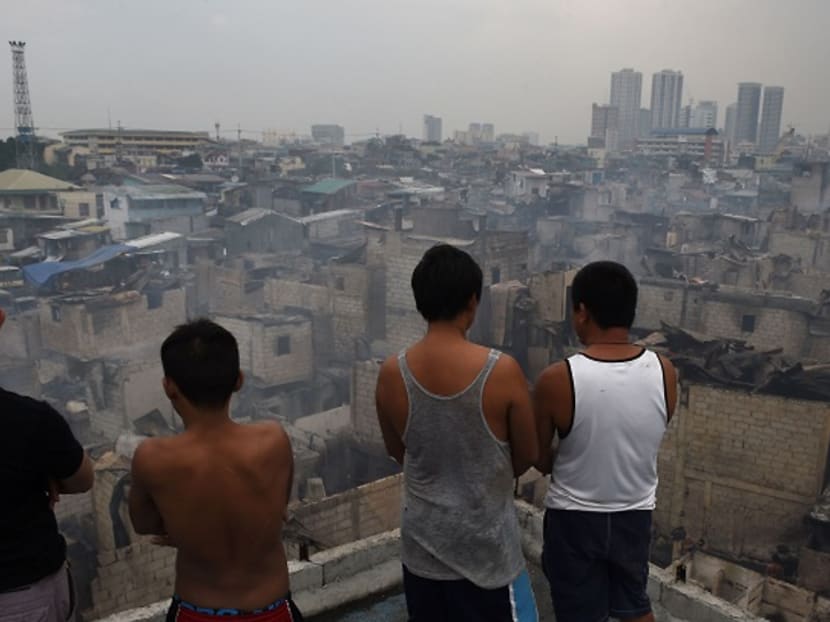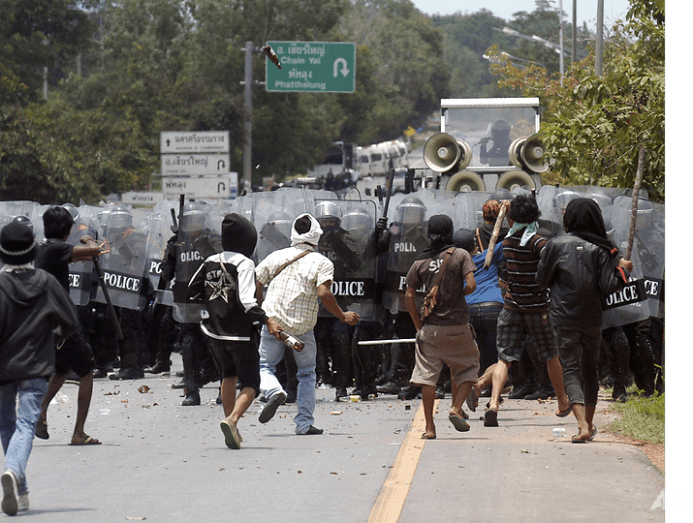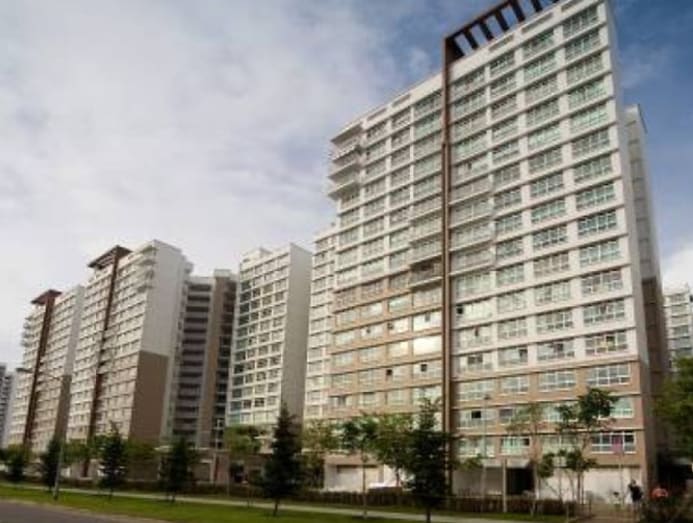Commentary: Inequality looms beneath the shiny facade of Southeast Asia's growth
Ad
Asia
Commentary: Inequality looms beneath the shiny facade of Southeast Asia's growth
Income inequality in Southeast Asia remain stubbornly high, despite potent regional growth but addressing this issue and its causes, specially the rural-urban divide, tin can create a more sustainable development pathway for ASEAN countries.

Residents sentry equally smoke billows from houses gutted past a burn overnight in an informal settlers area, nigh the due south harbour port in Manila on Feb eight, 2017. (Photo: AFP)
23 Apr 2022 12:30PM (Updated: 10 February 2022 02:20AM)
Singapore is the xxthursday century's near remarkable economic evolution story, and regional peers are hungry for every bit transformational growth. So it comes equally no surprise that Southeast Asia has produced remarkable growth in recent years. Asean's GDP doubled between 2001 and 2013, outpacing the United states, European union, and all Asian countries besides Red china.
Projected iv.8 per cent growth for 2022 is indicative of connected optimism. ASEAN'southward economic multifariousness, commitment to growth, and expanding workforce will provide a crucial advantage in the coming decades.
Even so, inequality remains stubbornly high. Governments may be imperiling economical and social progress by overlooking this challenge, in particular, the gap between rural and urban areas. While the strategy to compete in global manufacturing markets has compelled governments to focus on urban industrial infrastructure, rural evolution is becoming a political and economic necessity.
INEQUALITY IS UNEVEN Beyond SOUTHEAST ASIA
In a 2022 address, Ong Keng Yong of Singapore's Rajaratnam School of International Studies (RSIS) argued that ASEAN countries have fabricated strides in eradicating poverty and hunger, improving healthcare, and protecting vulnerable groups. Asian Development Bank (ADB) statistics for the Asia-Pacific bear this out. Between 1990 and 2010, extreme poverty – ordinarily defined by an earnings threshold of US$1.25 per day – in this region savage by more than 30 per centum points. Furthermore, income growth for the lesser 40 per cent outpaced that of the population equally a whole.
However, raising this earnings threshold to more than realistically measure poverty in developed countries paints a less encouraging pic. At The states$i.51, below which ADB declares a person "extremely" poor, poverty in Asean is high. It stands above xxx per cent in Laos, above 25 per cent in Indonesia and the Philippines, and above twenty per cent in Cambodia and Vietnam.
The GINI coefficient, a more comprehensive gauge of economic inequality, indicates a similar trend: Asean's is 42 (forty.5 adapted for population size). Countries with high scores which signal loftier inequality include Thailand (48.4, in 2011), Singapore (46.4, 2014), and Malaysia (46.2, 2009). Asean's inequality is lower than Cathay's (46.nine) but college than Bharat's (33.6).
While poverty is typically measured in monetary terms, other indicators reveal the hardships facing Asean's disadvantaged populations: Health, education, gender disparities in labour markets, and admission to services such every bit water, sanitation, and electricity. These challenges require a variety of policy levers across bones income redistribution; at the strategic level they necessitate a more robust commitment to narrowing Association of southeast asian nations's rural-urban development gap.
SOMETHING MUST Exist Done TO Accost INEQUALITY
Economical inequality tin hamper policy efforts to eradicate poverty, and limit the availability of majuscule for individuals to develop skills and nurture enterprises. In a manner, inequality is "institutionalised", perpetuated in part by insufficient social protection, regressive economic policies, and geographic favoritism in evolution. Inequality also restricts the emergence of a middle class that could heave consumer demand.

Global contest to attract manufacturing production is forcing newly developing countries to focus on low-wage manufacturing, luring low-skill workers away from agriculture. Yet, the chase to the bottom of the labour-cost continuum is exacerbating inequality. Furthermore, vulnerability to market fluctuations in certain sectors (consumer goods for example) is compromising the development of a stable economic base, making growth "fragile".
Addressing inequality Association of southeast asian nations-wide is challenging due to varying levels of development across and within countries. In rapidly industrialising economies like Vietnam and Thailand, skilled workers are abandoning rural agrestal livelihoods and migrating to urban industrial centers. In more than developed countries, wealth amassed through global fiscal and commercial activities is captured by urban economic and political elites, while rural areas autumn further behind.
For these challenges, there is no universal policy prescription aside from high-level commitments to cosmetic resource allotment.
RECHARTING THE Development PATH
The 2025 vision for the Association of southeast asian nations Economic Community (AEC) reveals how economic inequality may evolve in the coming decades. The AEC concept embraces regional integration to enhance global economic competitiveness, with Association of southeast asian nations countries cartoon on an effectively borderless market for factors of production like materials and labor.
This theory sounds very appealing just might not bear out practically. While enabling worker mobility broadens access to economic opportunities, many of ASEAN's everyman-income workers remain immobile due to relocation costs, vulnerability to doubt, and reliance on place-based community or family ties. Those who live in rural areas are also geographically isolated from higher-value-added manufacturing jobs that accumulate in urban areas.
Aside from economical risks, the widening rural-urban development gap could threaten political stability. Ignoring the plight of the rural poor comes at a political risk, particularly in countries with largely unified rural voting blocs like Malaysia, Indonesia, and Thailand. The economic struggle of rural low-income and working class citizens can foment destabilising political movements like those recently seen in the Philippines, Europe, and the Us.

The lesser line is while the AEC vision commendably prioritises inclusive growth, only domestic political will within ASEAN countries will determine whether all citizens benefit.
Initiatives to ameliorate educational activity, services, and living conditions crave not merely a strategic vision that complements broader evolution goals, but also consistency of commitment across political and concern cycles. Longer-term programs should target rural development, including the promotion of sustainable farming practices and the application of leading-edge technologies to improve ingather yield and amend food security.
Notwithstanding the environmental and social risks of agricultural industrialisation, technology-based productivity enhancement should also exist prioritised. Many such innovations already target "smart metropolis" programs, but an Association of southeast asian nations-specific "smart farms" initiative may exist needed.
START WITH THE UNIT OF THE HOUSEHOLD
Singapore'due south early poverty consolation program provides instructive examples in visionary leadership. For case, public housing was a social and economical building block throughout the country's decades of rapid evolution, improving public wellness and providing a vehicle for household-level investment. It also enabled a coordinated land employ regime that became a cornerstone of sustainability.

However, like many global cities Singapore continues to struggle with inequality as incomes amongst the wealthy go along to rise – and with them the price of living. Singapore's inequality challenges are those of a highly developed city-land, whereas the rest of Asean confronts inequality as manifest in function through the rural-urban development gap.
While the ii cases are not perfectly comparable, Singapore's multi-faceted and visionary strategy is worthy of emulation when refining the ASEAN development template to address the root causes of inequality.
Association of southeast asian nations's 21st century call-to-action should be the pursuit of college evolution standards and their normalisation across rural and urban areas – on bug like personal security, health, education, housing, and bones services. A robustly financed delivery to these bug can advance the cause of inclusive growth and social progress.
Asean must not forfeit the latent potential of its citizens by ignoring inequality.
Kris Hartley is a Lecturer at Cornell Academy and a not-resident fellow at the Chicago Council on Global Affairs.
Recent Searches
Trending Topics
hollidaythoreeduck1994.blogspot.com
Source: https://cnalifestyle.channelnewsasia.com/asia/commentary-inequality-looms-beneath-shiny-facade-southeast-asias-growth-284411

0 Response to "Commentary: Inequality looms beneath the shiny facade of Southeast Asia's growth"
Post a Comment